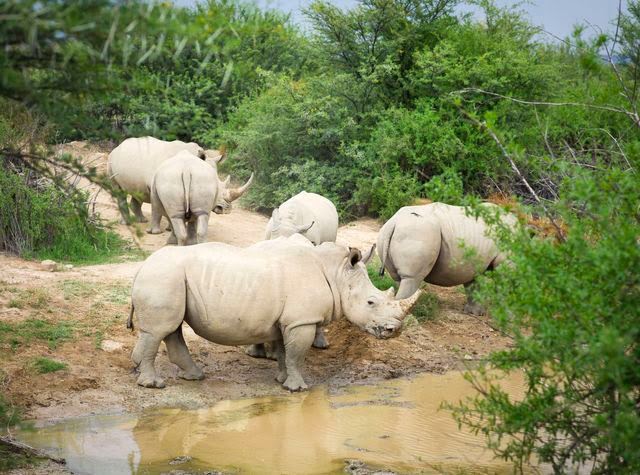Quck answer
White rhinos communicate through large communal dung piles, also known as “middens.” These mounds can be up to 9 feet wide and 2 feet tall and are used as a way for rhinos to leave messages for one another. By analyzing the chemical composition of the dung, rhinos can determine the sex, age, and reproductive status of other individuals in the area. They also use these mounds to mark their territory and establish dominance. Despite their size and strength, white rhinos are actually quite social animals and rely on these communication methods to navigate their environment.
Wild Animals

The white rhinoceros (Ceratotherium simum) has some unique ways of eliminating waste. AlonzoDesign/Peter Dazeley/Getty Images
Most people prefer to use designated areas for relieving themselves. It’s much better than finding feces all over public spaces. This behavior is not only limited to humans, but many animal species also use communal latrines. From ants to elephants, various mammals defecate in dung heaps, while some ant species create refuse chambers in their nests. In fact, the oldest animal latrine ever discovered was 240 million years ago, created by a herd of Dinodontosaurus, giant, herbivorous reptiles that resembled modern rhinos.
White rhinoceros, a critically endangered species, use communal latrines to communicate with each other. Researchers have suggested many reasons for animals using communal middens, such as keeping their living spaces free from harmful bacteria and marking borders of territories. However, white rhinos visit communal poop piles to smell each other’s excrement, indicating that intraspecies communication is the primary purpose of the communal latrine.

A group of white rhinos (Ceratotherium simum) at a water source in South Africa.
RyersonClark/Getty Images
Unlike social insects, white rhinos are not concerned about germs when approaching the communal poop pile. They are more interested in the information they can gather about their own species. The communal latrine helps them to learn about the health, fertility, and social status of other rhinos in the area. This behavior is yet another fascinating aspect of animal communication.
A recent study investigated the role of dung in white rhino communication. According to Courtney Marneweck, an ecologist and doctoral student at the University of KwaZulu-Natal in South Africa and lead author of the study, white rhinos use communal defecation sites to communicate. They can identify various details such as age, sex, territorial state, estrous state of the depositor, and how long ago they were there. It is also believed that they can recognize individuals. Every rhino of every age in the area will use the same dungheap, but the only one allowed to poop right in the very center of the pile is the resident dominant male. Marneweck also stated that lots of other animals use communal defecation sites for communication, sometimes only to mark territory and pick up signals from other animals. Next time you’re in a public bathroom, you might want to look around or take a sniff, and see what it tells you. Sloths don’t use latrines, but they only poop about once a week, and because it takes their food up to a month to digest, they’re always very constipated.
FAQ
1. What is a communal poop pile?
A communal poop pile is a large accumulation of rhino feces in a specific area, used by multiple individuals of a rhino population. This is a form of communication among white rhinos.
2. Why do white rhinos use communal poop piles?
White rhinos use communal poop piles to communicate with one another. These piles contain information about the age, sex, and reproductive status of the rhinos in the area. They can also indicate territory boundaries and serve as a way for rhinos to meet and interact with one another.
3. How do white rhinos use communal poop piles to communicate?
White rhinos use communal poop piles to communicate through their sense of smell. They can detect the chemical signals in the feces, which provide information about the rhinos in the area.
4. Are communal poop piles unique to white rhinos?
No, communal poop piles are also used by other animal species for communication, including elephants, meerkats, and some species of primates.
5. How large can communal poop piles get?
Communal poop piles can get quite large, with some piles containing up to several hundred individual droppings. The size of the pile can vary depending on the size of the rhino population in the area and how frequently they use the site.
6. Do male and female rhinos use communal poop piles differently?
Yes, male and female rhinos use communal poop piles differently. Males will often defecate outside of the communal pile to mark their territory, while females tend to use the communal pile more frequently for communication with other rhinos.
7. Can researchers study communal poop piles to learn more about white rhino populations?
Yes, researchers can study communal poop piles to learn more about white rhino populations. By analyzing the chemical signals in the feces, researchers can determine the sex, age, and reproductive status of the rhinos in the area. This information can be used to better understand the population dynamics of white rhinos.
8. How important is the use of communal poop piles to white rhino survival?
The use of communal poop piles is an important aspect of white rhino survival. By communicating with one another, rhinos can establish territories, find mates, and avoid conflicts with other rhinos. Without this form of communication, their chances of survival in the wild would be greatly decreased.
9. Can human activity disrupt the use of communal poop piles by white rhinos?
Yes, human activity can disrupt the use of communal poop piles by white rhinos. Habitat destruction, poaching, and other human activities can affect the size and location of the piles, which can impact the ability of rhinos to communicate with one another.
10. How can we protect the use of communal poop piles by white rhinos?
Protecting the habitat of white rhinos is the best way to ensure the continued use of communal poop piles. This includes protecting their natural range and implementing conservation measures to prevent habitat destruction and poaching. It is also important to educate the public about the importance of these piles for rhino survival.
11. What other forms of communication do white rhinos use?
White rhinos also communicate through vocalizations, body language, and scent marking. These forms of communication are used in addition to communal poop piles and are important for establishing social hierarchies and maintaining territories.





Leave a Reply